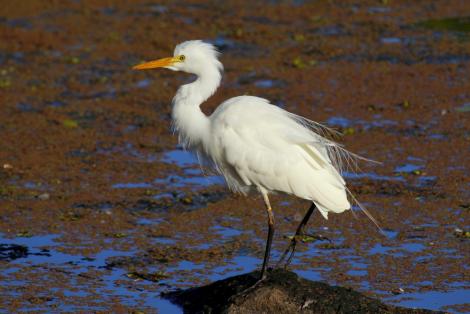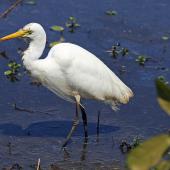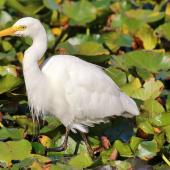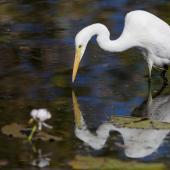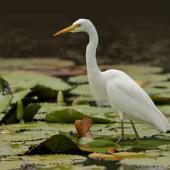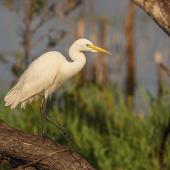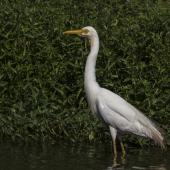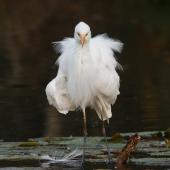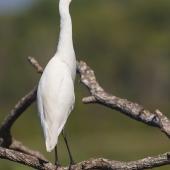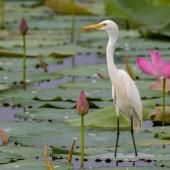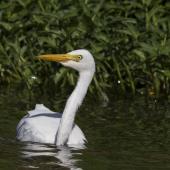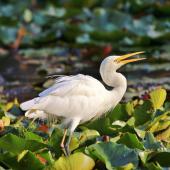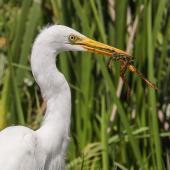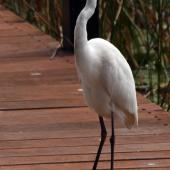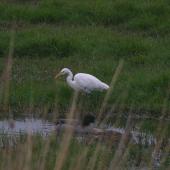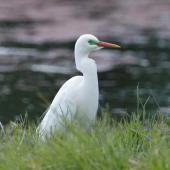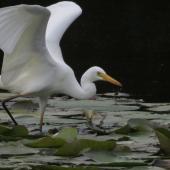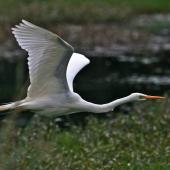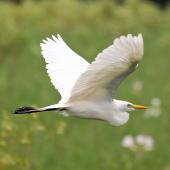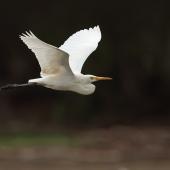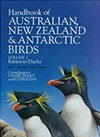Plumed egret
Ardea intermedia (Wagler, 1829)
Order: Pelecaniformes
Family: Ardeidae
Other names: intermediate egret, yellow-billed egret, short-billed egret, lesser egret
Geographical variation: There are 3 sub-species. New Zealand birds are all likely to be A.i. plumifera
The 4th edition of the Checklist of the birds of New Zealand (2010) states that “Ardeid taxonomy is unstable at present”. A birder with a library of field guides from around the world or on-line checklists may encounter an array of common and scientific names for this bird. Plumed egret and intermediate egret are the common names used in New Zealand. Some recent books and on-line lists use the scientific name Mesophoyx intermedia. Egretta intermedia appears in older books. Ardea intermedia is the scientific name in the 2010 Checklist of the birds of New Zealand.
Identification
The plumed egret is a medium-sized all-white egret with a relatively short, stout yellow bill. The bill turns reddish in breeding plumage. The neck is about the same length as the body, and typically held in an 'S'-shaped curve. When breeding, plumed egrets acquire long filamentous plumes from scapulars and breast, and green facial skin. The long legs are generally dark.
Voice: silent in New Zealand
Similar species: eight species of mainly white egrets, herons, ibises and spoonbills have been recorded in New Zealand. All are sometimes seen on their own, making size estimation difficult. Other field marks should be added to impression of size, for separation, particularly from little egret and white heron.
The white ibis and both species of spoonbill have very different bill shapes from egrets and should be easily separated. Royal spoonbill, which has a black bill, is the only common species among this group.
Cattle egret in non-breeding plumage is all white with a yellow bill, but is much smaller and more stocky with shorter neck and legs. Long feathers under the bill give a “jowly” appearance. The white morph reef heron has been recorded at least once in New Zealand. It has a more hunched, horizontal stance and dark grey bill. The reef heron is strictly marine and usually seen on rocky shorelines. In contrast, the plumed egret is most often seen inland around fresh water.
Little egret and white heron, like plumed egret acquire filamentous plumes from the breast and scapulars in breeding plumage. The little egret is smaller with a long, black bill which is much finer than in the plumed egret, with only traces of yellow. Little egrets in New Zealand will have some yellow on their feet, even if only on the underside. They are typically more active and erratic than plumed egrets which by comparison are slow and graceful when feeding. The white heron is bigger and has a longer neck that is 1.5 times its body length, with a more sharply kinked 'S' shape than plumed. A diagnostic field mark separating these two species is that the gape line on white herons goes back beyond the eye, but on plumed egrets it stops level with the back of the eye.
Distribution and habitat
Plumed egrets are widespread and common through much of Africa, Asia and Australia, mainly occurring in freshwater wetlands. This contrasts with little egret (especially) and white heron, which are more often seen in estuaries. Ironically, the first New Zealand record was at Manawatu Estuary (1973).
New Zealand records
Plumed egrets have been recorded in New Zealand at least 18 times, with several more unconfirmed sightings. They have been seen from Kaikohe south to Lake Ellesmere, and from Cobden (West Coast) to Hawke’s Bay, with 4 records from the wetlands of the lower Waikato River. The most recent record was one at Tomahawk Lagoon, Dunedin, in November 2014.
Behaviour and ecology
A bird primarily of marshy freshwater, inland wetlands, river edges, suburban ditches, or wet paddocks, and occasionally saline estuaries. Overseas, plumed egrets are often seen near human habitation. Some may arrive in New Zealand with migrating cattle egrets.
Food
Fish, frogs and insects.
Websites
References
Brazil, M. 2008. Birds of East Asia. Christopher Helm. London.
Heather, B.D.; Robertson, H.A. 2005. The field guide to the birds of New Zealand. Penguin Books, Auckland.
Marchant, S; Higgins, P.J. (eds) 1990. Handbook of Australian, New Zealand and Antarctic birds. Vol.1, ratites to ducks. Oxford University Press, Melbourne.
Miskelly, C.M.; Crossland, A.C.; Sagar, P.M.; Saville, I.; Tennyson, A.J.D.; Bell, E.A. 2015. Vagrant and extra-limital bird records accepted by the Birds New Zealand Records Appraisal Committee 2013-2014. Notornis 62: 85-95.
Recommended citation
Hammond, P. 2013 [updated 2017]. Plumed egret. In Miskelly, C.M. (ed.) New Zealand Birds Online. www.nzbirdsonline.org.nz
Plumed egret
- Breeding season
-
- Jul
- Aug
- Sep
- Oct
- Nov
- Dec
- Jan
- Feb
- Mar
- Apr
- May
- Jun
- Egg laying dates
-
- Jul
- Aug
- Sep
- Oct
- Nov
- Dec
- Jan
- Feb
- Mar
- Apr
- May
- Jun
Plumed egret
- Breeding season
-
- Jul
- Aug
- Sep
- Oct
- Nov
- Dec
- Jan
- Feb
- Mar
- Apr
- May
- Jun
- Egg laying dates
-
- Jul
- Aug
- Sep
- Oct
- Nov
- Dec
- Jan
- Feb
- Mar
- Apr
- May
- Jun




